towing TESLA MODEL S 2014 Owner's manual (Europe)
[x] Cancel search | Manufacturer: TESLA, Model Year: 2014, Model line: MODEL S, Model: TESLA MODEL S 2014Pages: 152, PDF Size: 17.5 MB
Page 69 of 152
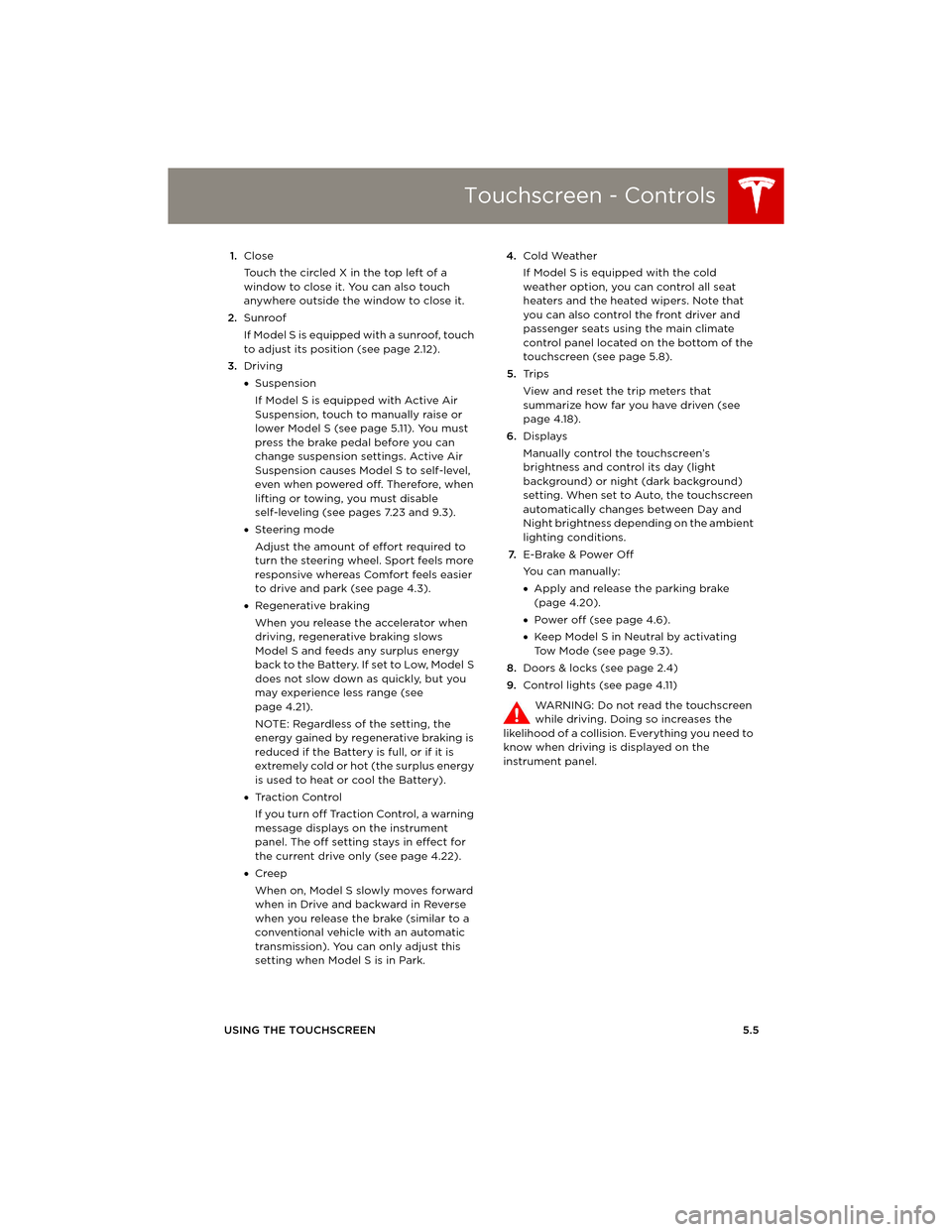
Touchscreen - Controls
USING THE TOUCHSCREEN5.5 1.Close
Touch the circled X in the top left of a
window to close it. You can also touch
anywhere outside the window to close it.
2.Sunroof
If Model S is equipped with a sunroof, touch
to adjust its position (see page 2.12).
3.Driving
•Suspension
If Model S is equipped with Active Air
Suspension, touch to manually raise or
lower Model S (see page 5.11). You must
press the brake pedal before you can
change suspension settings. Active Air
Suspension causes Model S to self-level,
even when powered off. Therefore, when
lifting or towing, you must disable
self-leveling (see pages 7.23 and 9.3).
•Steering mode
Adjust the amount of effort required to
turn the steering wheel. Sport feels more
responsive whereas Comfort feels easier
to drive and park (see page 4.3).
•Regenerative braking
When you release the accelerator when
driving, regenerative braking slows
Model S and feeds any surplus energy
b a c k t o t h e B a t t e r y. I f s e t t o L o w, M o d e l S
does not slow down as quickly, but you
may experience less range (see
page 4.21).
NOTE: Regardless of the setting, the
energy gained by regenerative braking is
reduced if the Battery is full, or if it is
extremely cold or hot (the surplus energy
is used to heat or cool the Battery).
•Tr a c t i o n C o n t r o l
If you turn off Traction Control, a warning
message displays on the instrument
panel. The off setting stays in effect for
the current drive only (see page 4.22).
•Creep
When on, Model S slowly moves forward
when in Drive and backward in Reverse
when you release the brake (similar to a
conventional vehicle with an automatic
transmission). You can only adjust this
setting when Model S is in Park.4.Cold Weather
If Model S is equipped with the cold
weather option, you can control all seat
heaters and the heated wipers. Note that
you can also control the front driver and
passenger seats using the main climate
control panel located on the bottom of the
touchscreen (see page 5.8).
5.Tr i p s
View and reset the trip meters that
summarize how far you have driven (see
page 4.18).
6.Displays
Manually control the touchscreen’s
brightness and control its day (light
background) or night (dark background)
setting. When set to Auto, the touchscreen
automatically changes between Day and
Night brightness depending on the ambient
lighting conditions.
7.E-Brake & Power Off
You can manually:
•Apply and release the parking brake
(page 4.20).
•Power off (see page 4.6).
•Keep Model S in Neutral by activating
Tow Mode (see page 9.3).
8.Doors & locks (see page 2.4)
9.Control lights (see page 4.11)
WARNING: Do not read the touchscreen
while driving. Doing so increases the
likelihood of a collision. Everything you need to
know when driving is displayed on the
instrument panel.
book.book Page 5 Friday, July 19, 2013 12:53 PM
Page 123 of 152

8.1
SPECIFICATIONS
Identification Labels
Vehicle Identification Number..................... 8.2
Vehicle Loading
Load Capacity Labeling ................................. 8.3
Calculating Load Limits ................................ 8.4
Towing a Trailer ............................................... 8.4
Dimensions and Weights
Exterior Dimensions ........................................ 8.5
Weights ................................................................ 8.5
Subsystems
Motor .................................................................... 8.6
Transmission...................................................... 8.6
Steering ............................................................... 8.6
Brakes .................................................................. 8.6
Suspension .......................................................... 8.7
Battery - 12V ....................................................... 8.7
Battery - High Voltage ................................... 8.7
Wheels and Tires
Wheel Specifications ..................................... 8.8
Wheel Alignment Values .............................. 8.8
Tire Specifications........................................... 8.8
Understanding Tire Markings..................... 8.10
book.book Page 1 Friday, July 19, 2013 12:53 PM
Page 126 of 152
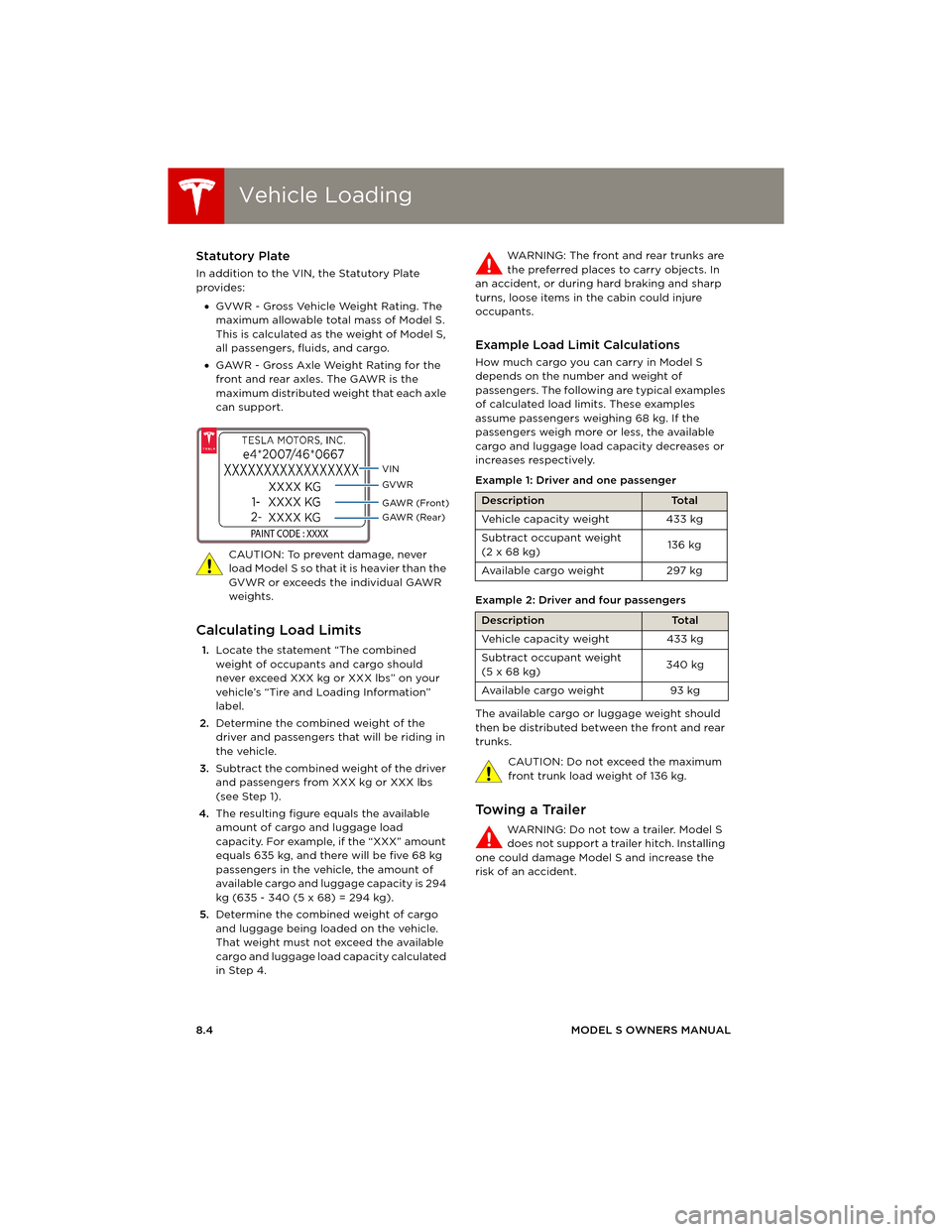
Vehicle LoadingVehicle Loading
8.4MODEL S OWNERS MANUAL
Statutory Plate
In addition to the VIN, the Statutory Plate
provides:
•GVWR - Gross Vehicle Weight Rating. The
maximum allowable total mass of Model S.
This is calculated as the weight of Model S,
all passengers, fluids, and cargo.
•GAWR - Gross Axle Weight Rating for the
front and rear axles. The GAWR is the
maximum distributed weight that each axle
can support.
CAUTION: To prevent damage, never
load Model S so that it is heavier than the
GVWR or exceeds the individual GAWR
weights.
Calculating Load Limits
1.Locate the statement “The combined
weight of occupants and cargo should
never exceed XXX kg or XXX lbs” on your
vehicle’s “Tire and Loading Information”
label.
2.Determine the combined weight of the
driver and passengers that will be riding in
the vehicle.
3.Subtract the combined weight of the driver
and passengers from XXX kg or XXX lbs
(see Step 1).
4.The resulting figure equals the available
amount of cargo and luggage load
capacity. For example, if the “XXX” amount
equals 635 kg, and there will be five 68 kg
passengers in the vehicle, the amount of
available cargo and luggage capacity is 294
kg (635 - 340 (5 x 68) = 294 kg).
5.Determine the combined weight of cargo
and luggage being loaded on the vehicle.
That weight must not exceed the available
cargo and luggage load capacity calculated
in Step 4. WARNING: The front and rear trunks are
the preferred places to carry objects. In
an accident, or during hard braking and sharp
turns, loose items in the cabin could injure
occupants.
Example Load Limit Calculations
How much cargo you can carry in Model S
depends on the number and weight of
passengers. The following are typical examples
of calculated load limits. These examples
assume passengers weighing 68 kg. If the
passengers weigh more or less, the available
cargo and luggage load capacity decreases or
increases respectively.
Example 1: Driver and one passenger
Example 2: Driver and four passengers
The available cargo or luggage weight should
then be distributed between the front and rear
trunks.
CAUTION: Do not exceed the maximum
front trunk load weight of 136 kg.
Towing a Trailer
WARNING: Do not tow a trailer. Model S
does not support a trailer hitch. Installing
one could damage Model S and increase the
risk of an accident.
DescriptionTo t a l
Vehicle capacity weight 433 kg
Subtract occupant weight
(2 x 68 kg)136 kg
Ava i l a b l e c a rg o we i g h t 2 97 kg
DescriptionTo t a l
Vehicle capacity weight 433 kg
Subtract occupant weight
(5 x 68 kg)340 kg
Ava i l a b l e c a rg o we i g h t 93 kg
book.book Page 4 Friday, July 19, 2013 12:53 PM
Page 127 of 152
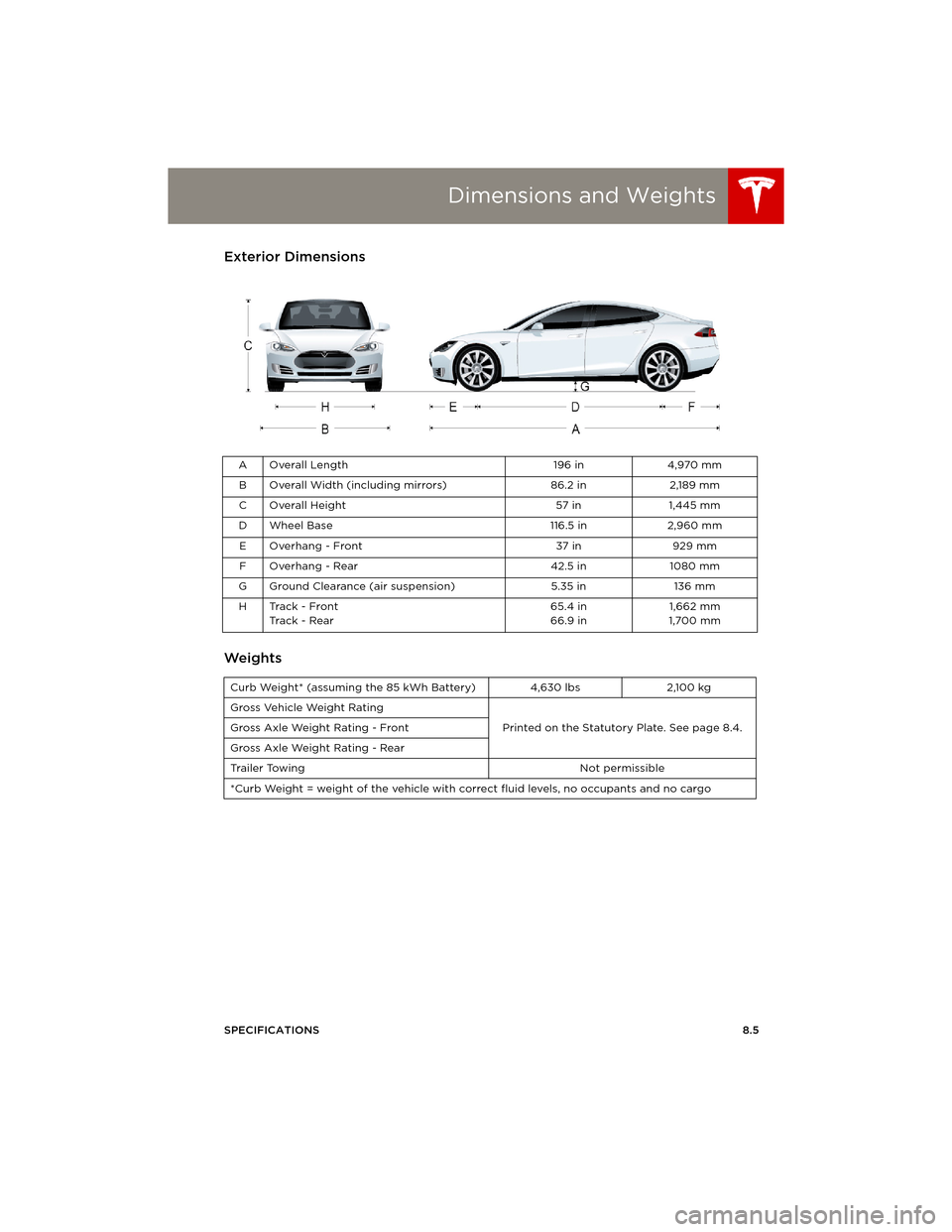
Dimensions and Weights
SPECIFICATIONS8.5
Dimensions and WeightsExterior Dimensions
Weights
AOverall Length 196 in 4,970 mm
B Overall Width (including mirrors) 86.2 in 2,189 mm
C Overall Height 57 in 1,445 mm
D Wheel Base 116.5 in 2,960 mm
EOverhang - Front 37 in 929 mm
F Overhang - Rear 42.5 in 1080 mm
G Ground Clearance (air suspension) 5.35 in 136 mm
HTrack - Front
Track - Rear65.4 in
66.9 in1,662 mm
1,700 mm
Curb Weight* (assuming the 85 kWh Battery) 4,630 lbs 2,100 kg
Gross Vehicle Weight Rating
Printed on the Statutory Plate. See page 8.4. Gross Axle Weight Rating - Front
Gross Axle Weight Rating - Rear
Trailer Towing Not permissible
*Curb Weight = weight of the vehicle with correct fluid levels, no occupants and no cargo
book.book Page 5 Friday, July 19, 2013 12:53 PM
Page 138 of 152
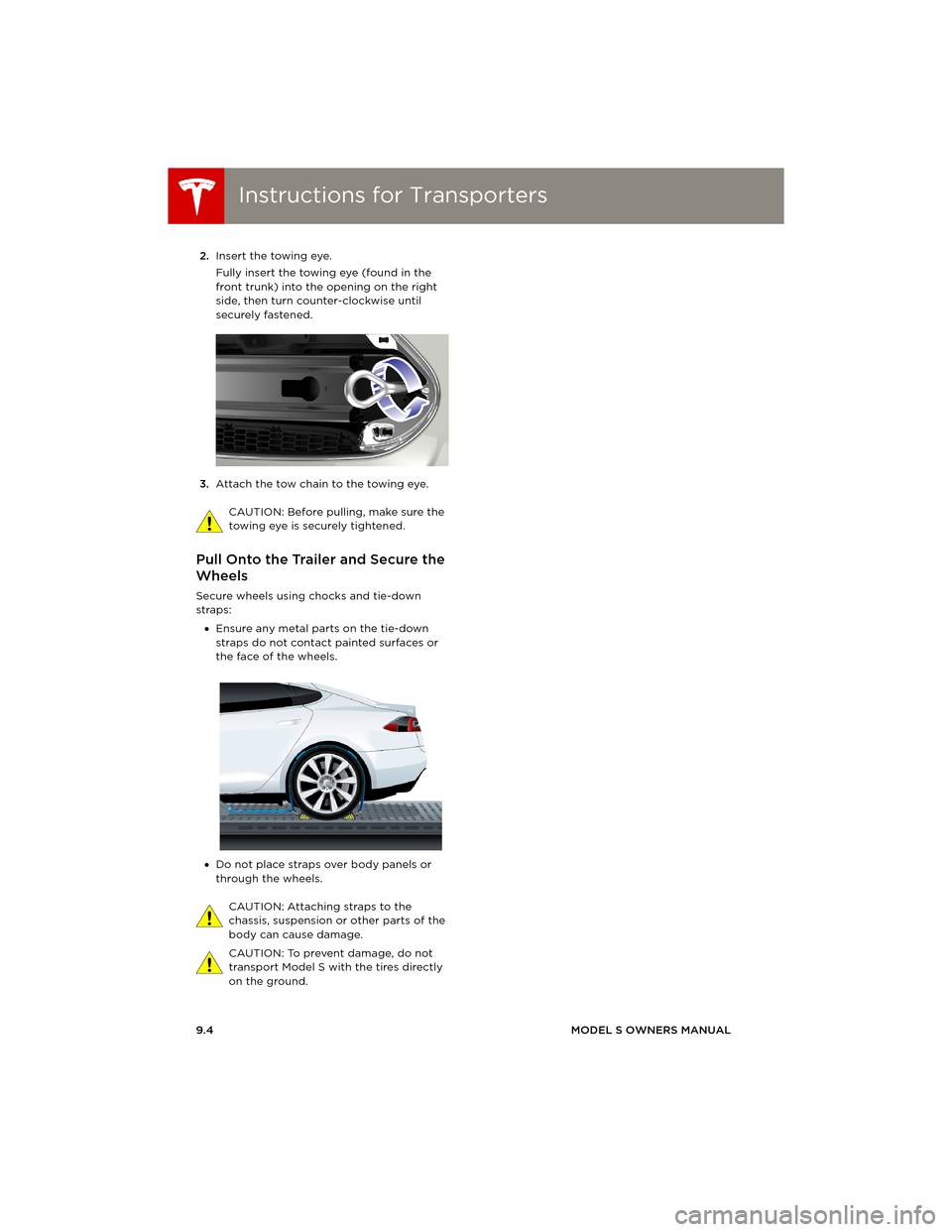
Instructions for TransportersInstructions for Transporters
9.4MODEL S OWNERS MANUAL 2.Insert the towing eye.
Fully insert the towing eye (found in the
front trunk) into the opening on the right
side, then turn counter-clockwise until
securely fastened.
3.Attach the tow chain to the towing eye.
CAUTION: Before pulling, make sure the
towing eye is securely tightened.
Pull Onto the Trailer and Secure the
Wheels
Secure wheels using chocks and tie-down
straps:
•Ensure any metal parts on the tie-down
straps do not contact painted surfaces or
the face of the wheels.
•Do not place straps over body panels or
through the wheels.
CAUTION: Attaching straps to the
chassis, suspension or other parts of the
body can cause damage.
CAUTION: To prevent damage, do not
transport Model S with the tires directly
on the ground.
book.book Page 4 Friday, July 19, 2013 12:53 PM
Page 148 of 152
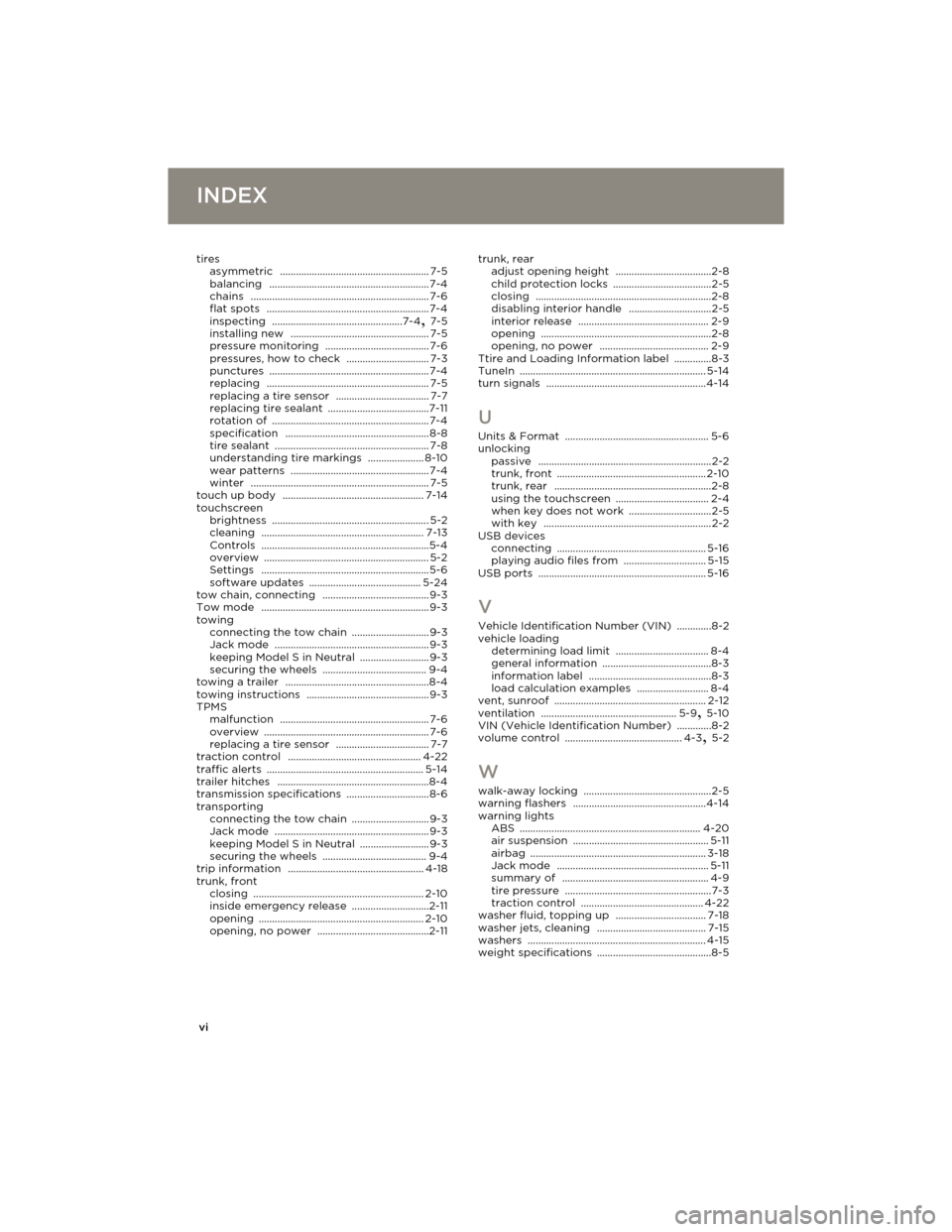
vi
INDEXINDEX
tires
asymmetric ........................................................ 7-5
balancing ............................................................7-4
chains ................................................................... 7-6
flat spots .............................................................7-4
inspecting .................................................7-4, 7-5
installing new .................................................... 7-5
pressure monitoring ....................................... 7-6
pressures, how to check ............................... 7-3
punctures ............................................................7-4
replacing ............................................................. 7-5
replacing a tire sensor ................................... 7-7
replacing tire sealant ......................................7-11
rotation of ...........................................................7-4
specification ......................................................8-8
tire sealant .......................................................... 7-8
understanding tire markings ..................... 8-10
wear patterns ....................................................7-4
winter ................................................................... 7-5
touch up body ..................................................... 7-14
touchscreen
brightness
........................................................... 5-2
cleaning ............................................................. 7-13
Controls ...............................................................5-4
overview .............................................................. 5-2
Settings ............................................................... 5-6
software updates .......................................... 5-24
tow chain, connecting ........................................ 9-3
Tow mode ............................................................... 9-3
towing
connecting the tow chain
............................. 9-3
Jack mode .......................................................... 9-3
keeping Model S in Neutral ..........................9-3
securing the wheels ....................................... 9-4
towing a trailer ......................................................8-4
towing instructions .............................................. 9-3
TPMS
malfunction
........................................................ 7-6
overview .............................................................. 7-6
replacing a tire sensor ................................... 7-7
traction control .................................................. 4-22
traffic alerts ........................................................... 5-14
trailer hitches .........................................................8-4
transmission specifications ...............................8-6
transporting
connecting the tow chain
............................. 9-3
Jack mode .......................................................... 9-3
keeping Model S in Neutral ..........................9-3
securing the wheels ....................................... 9-4
trip information ................................................... 4-18
trunk, front
closing
................................................................ 2-10
inside emergency release .............................2-11
opening .............................................................. 2-10
opening, no power ..........................................2-11trunk, rear
adjust opening height
....................................2-8
child protection locks .....................................2-5
closing ..................................................................2-8
disabling interior handle ...............................2-5
interior release ................................................. 2-9
opening ................................................................2-8
opening, no power ......................................... 2-9
Ttire and Loading Information label ..............8-3
TuneIn ...................................................................... 5-14
turn signals ............................................................4-14
U
Units & Format ...................................................... 5-6
unlocking
passive
.................................................................2-2
trunk, front ........................................................ 2-10
trunk, rear ...........................................................2-8
using the touchscreen ................................... 2-4
when key does not work ...............................2-5
with key ...............................................................2-2
USB devices
connecting
........................................................ 5-16
playing audio files from ............................... 5-15
USB ports ............................................................... 5-16
V
Vehicle Identification Number (VIN) .............8-2
vehicle loading
determining load limit
................................... 8-4
general information .........................................8-3
information label ..............................................8-3
load calculation examples ........................... 8-4
vent, sunroof ......................................................... 2-12
ventilation ................................................... 5-9, 5-10
VIN (Vehicle Identification Number) .............8-2
volume control ............................................ 4-3, 5-2
W
walk-away locking ................................................2-5
warning flashers ..................................................4-14
warning lights
ABS
.................................................................... 4-20
air suspension ................................................... 5-11
airbag .................................................................. 3-18
Jack mode ......................................................... 5-11
summary of ....................................................... 4-9
tire pressure .......................................................7-3
traction control .............................................. 4-22
washer fluid, topping up .................................. 7-18
washer jets, cleaning ......................................... 7-15
washers ................................................................... 4-15
weight specifications ...........................................8-5
book.book Page vi Friday, July 19, 2013 12:53 PM